Extra reading.ppt
- Количество слайдов: 33
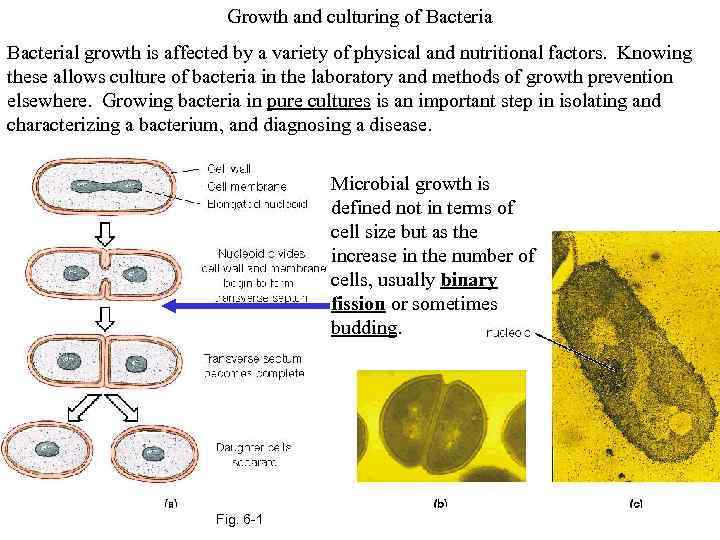
Growth and culturing of Bacterial growth is affected by a variety of physical and nutritional factors. Knowing these allows culture of bacteria in the laboratory and methods of growth prevention elsewhere. Growing bacteria in pure cultures is an important step in isolating and characterizing a bacterium, and diagnosing a disease. Microbial growth is defined not in terms of cell size but as the increase in the number of cells, usually binary fission or sometimes budding. Fig. 6 -1
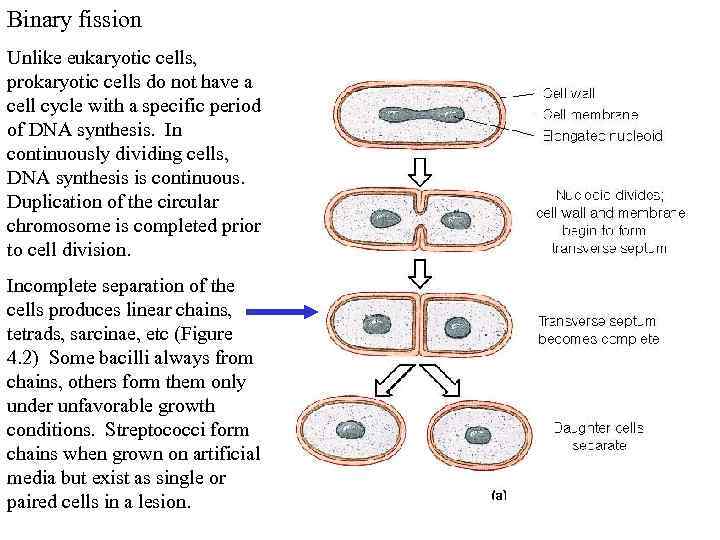
Binary fission Unlike eukaryotic cells, prokaryotic cells do not have a cell cycle with a specific period of DNA synthesis. In continuously dividing cells, DNA synthesis is continuous. Duplication of the circular chromosome is completed prior to cell division. Incomplete separation of the cells produces linear chains, tetrads, sarcinae, etc (Figure 4. 2) Some bacilli always from chains, others form them only under unfavorable growth conditions. Streptococci form chains when grown on artificial media but exist as single or paired cells in a lesion.
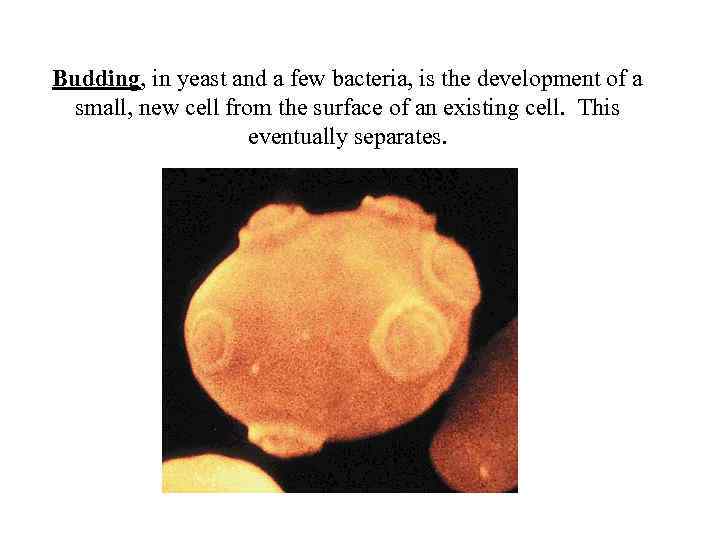
Budding, in yeast and a few bacteria, is the development of a small, new cell from the surface of an existing cell. This eventually separates.
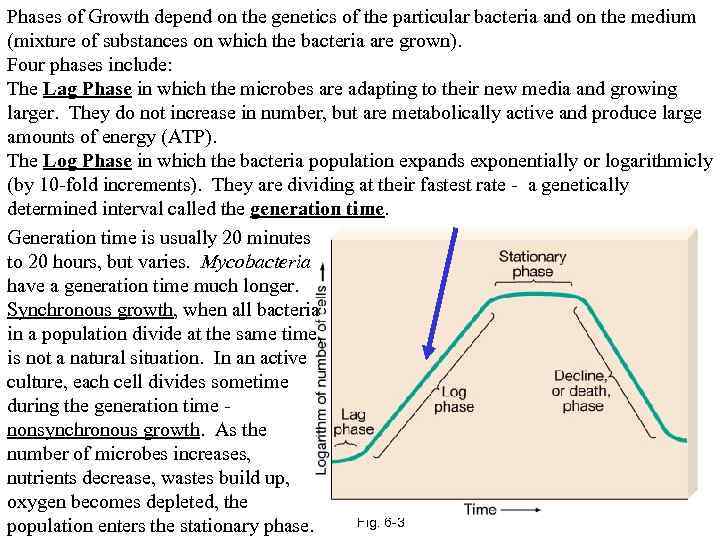
Phases of Growth depend on the genetics of the particular bacteria and on the medium (mixture of substances on which the bacteria are grown). Four phases include: The Lag Phase in which the microbes are adapting to their new media and growing larger. They do not increase in number, but are metabolically active and produce large amounts of energy (ATP). The Log Phase in which the bacteria population expands exponentially or logarithmicly (by 10 -fold increments). They are dividing at their fastest rate - a genetically determined interval called the generation time. Generation time is usually 20 minutes to 20 hours, but varies. Mycobacteria have a generation time much longer. Synchronous growth, when all bacteria in a population divide at the same time, is not a natural situation. In an active culture, each cell divides sometime during the generation time nonsynchronous growth. As the number of microbes increases, nutrients decrease, wastes build up, oxygen becomes depleted, the Fig. 6 -3 population enters the stationary phase.
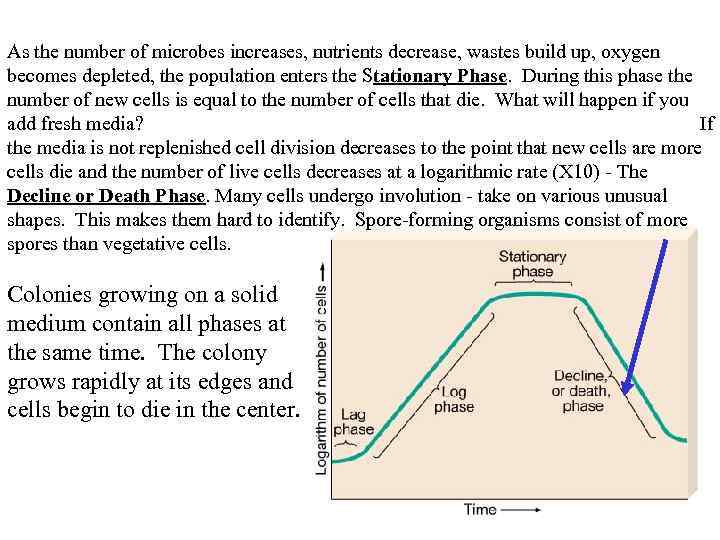
As the number of microbes increases, nutrients decrease, wastes build up, oxygen becomes depleted, the population enters the Stationary Phase. During this phase the number of new cells is equal to the number of cells that die. What will happen if you add fresh media? If the media is not replenished cell division decreases to the point that new cells are more cells die and the number of live cells decreases at a logarithmic rate (X 10) - The Decline or Death Phase. Many cells undergo involution - take on various unusual shapes. This makes them hard to identify. Spore-forming organisms consist of more spores than vegetative cells. Colonies growing on a solid medium contain all phases at the same time. The colony grows rapidly at its edges and cells begin to die in the center.
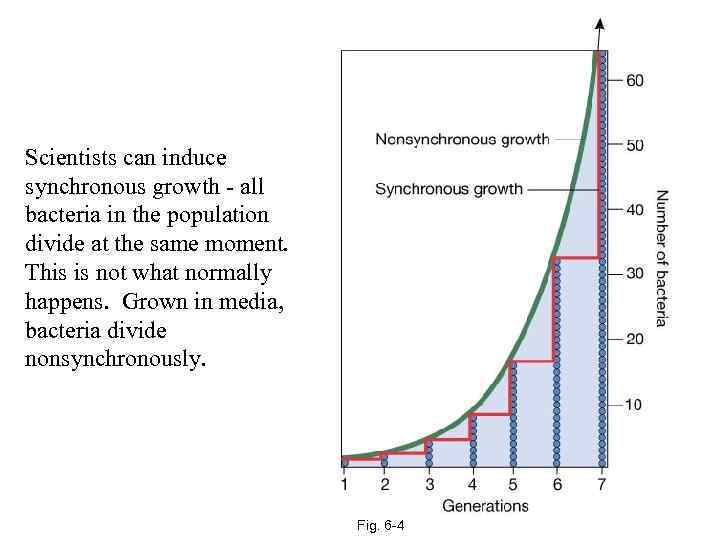
Scientists can induce synchronous growth - all bacteria in the population divide at the same moment. This is not what normally happens. Grown in media, bacteria divide nonsynchronously. Fig. 6 -4
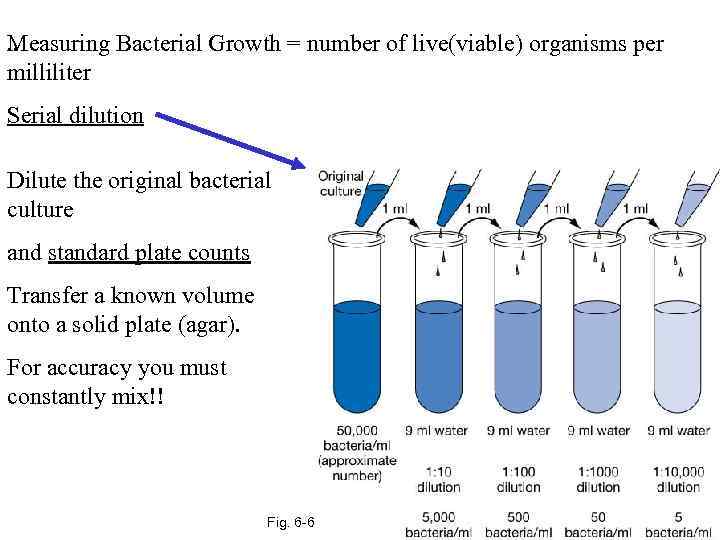
Measuring Bacterial Growth = number of live(viable) organisms per. . milliliter Serial dilution Dilute the original bacterial culture and standard plate counts Transfer a known volume onto a solid plate (agar). For accuracy you must constantly mix!! Fig. 6 -6
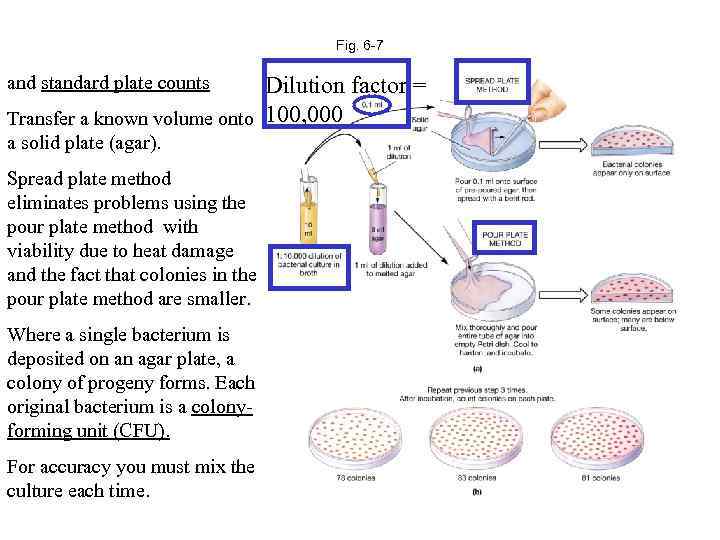
Fig. 6 -7 and standard plate counts Dilution factor = Transfer a known volume onto 100, 000 a solid plate (agar). Spread plate method eliminates problems using the pour plate method with viability due to heat damage and the fact that colonies in the pour plate method are smaller. Where a single bacterium is deposited on an agar plate, a colony of progeny forms. Each original bacterium is a colonyforming unit (CFU). For accuracy you must mix the culture each time.
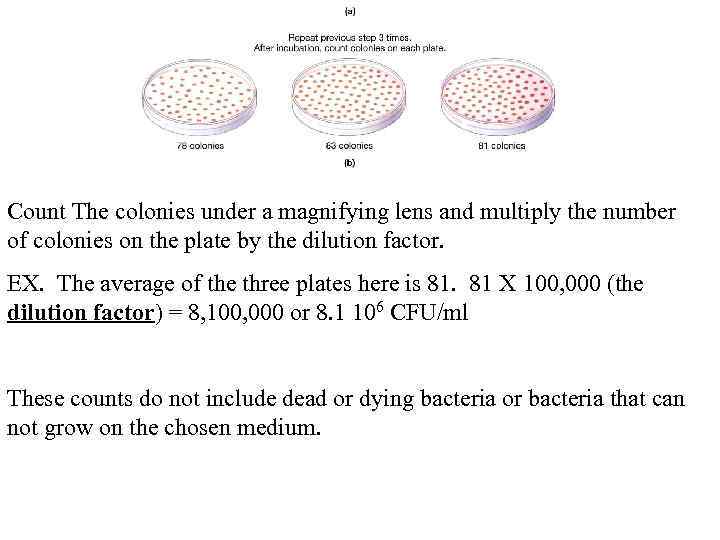
Count The colonies under a magnifying lens and multiply the number of colonies on the plate by the dilution factor. EX. The average of the three plates here is 81. 81 X 100, 000 (the dilution factor) = 8, 100, 000 or 8. 1 106 CFU/ml These counts do not include dead or dying bacteria or bacteria that can not grow on the chosen medium.
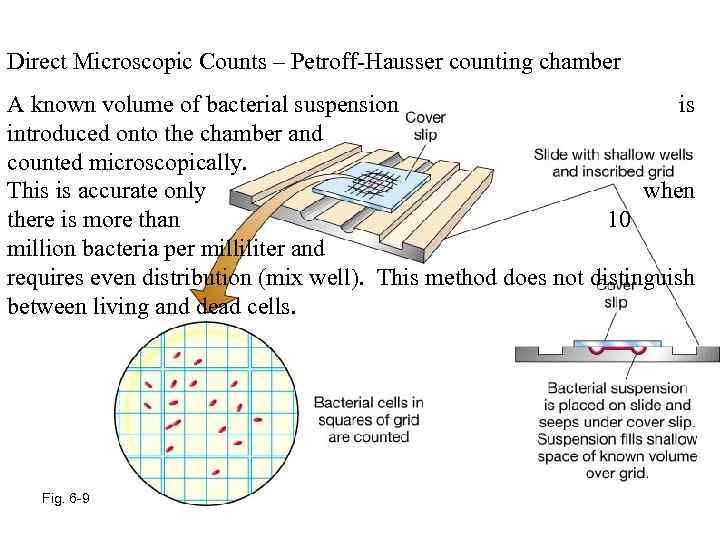
Direct Microscopic Counts – Petroff-Hausser counting chamber A known volume of bacterial suspension is introduced onto the chamber and counted microscopically. This is accurate only when there is more than 10 million bacteria per milliliter and requires even distribution (mix well). This method does not distinguish between living and dead cells. Fig. 6 -9
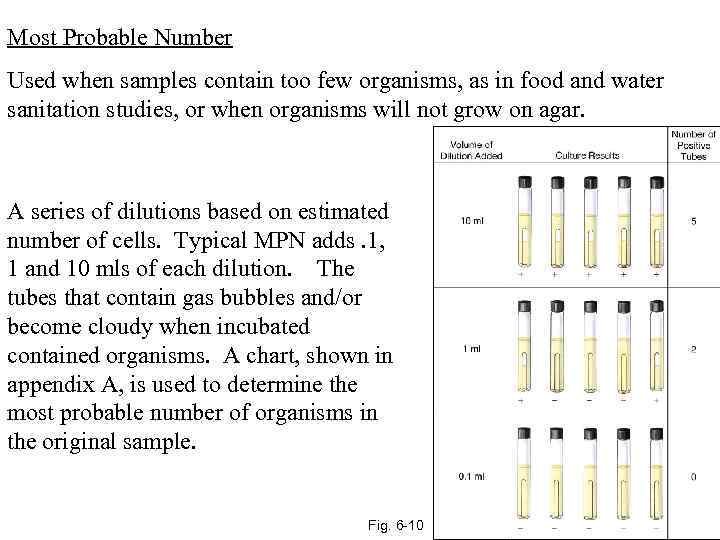
Most Probable Number Used when samples contain too few organisms, as in food and water sanitation studies, or when organisms will not grow on agar. A series of dilutions based on estimated number of cells. Typical MPN adds. 1, 1 and 10 mls of each dilution. The tubes that contain gas bubbles and/or become cloudy when incubated contained organisms. A chart, shown in appendix A, is used to determine the most probable number of organisms in the original sample. Fig. 6 -10
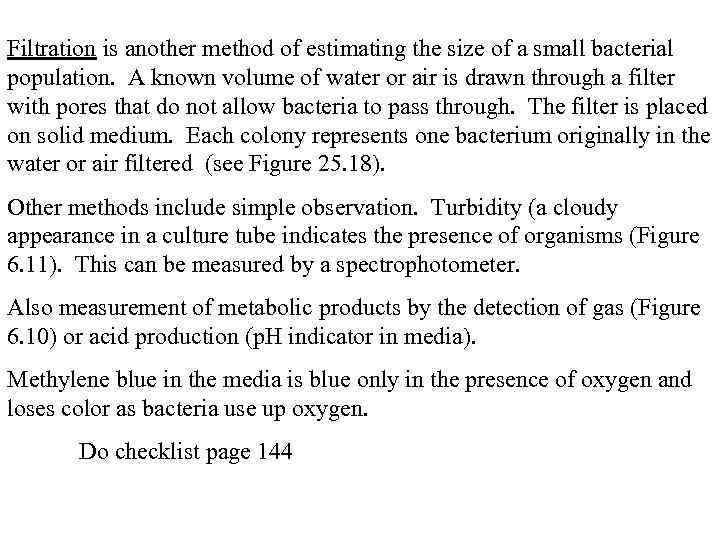
Filtration is another method of estimating the size of a small bacterial population. A known volume of water or air is drawn through a filter with pores that do not allow bacteria to pass through. The filter is placed on solid medium. Each colony represents one bacterium originally in the water or air filtered (see Figure 25. 18). Other methods include simple observation. Turbidity (a cloudy appearance in a culture tube indicates the presence of organisms (Figure 6. 11). This can be measured by a spectrophotometer. Also measurement of metabolic products by the detection of gas (Figure 6. 10) or acid production (p. H indicator in media). Methylene blue in the media is blue only in the presence of oxygen and loses color as bacteria use up oxygen. Do checklist page 144
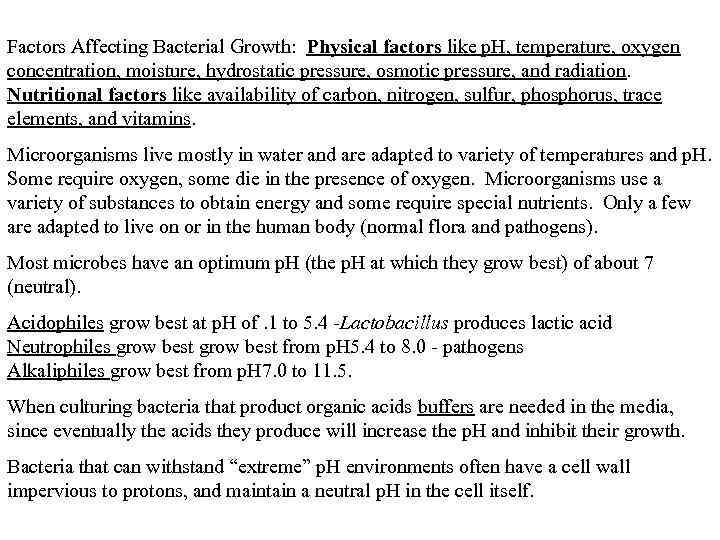
Factors Affecting Bacterial Growth: Physical factors like p. H, temperature, oxygen concentration, moisture, hydrostatic pressure, osmotic pressure, and radiation. Nutritional factors like availability of carbon, nitrogen, sulfur, phosphorus, trace elements, and vitamins. Microorganisms live mostly in water and are adapted to variety of temperatures and p. H. Some require oxygen, some die in the presence of oxygen. Microorganisms use a variety of substances to obtain energy and some require special nutrients. Only a few are adapted to live on or in the human body (normal flora and pathogens). Most microbes have an optimum p. H (the p. H at which they grow best) of about 7 (neutral). Acidophiles grow best at p. H of. 1 to 5. 4 -Lactobacillus produces lactic acid Neutrophiles grow best from p. H 5. 4 to 8. 0 - pathogens Alkaliphiles grow best from p. H 7. 0 to 11. 5. When culturing bacteria that product organic acids buffers are needed in the media, since eventually the acids they produce will increase the p. H and inhibit their growth. Bacteria that can withstand “extreme” p. H environments often have a cell wall impervious to protons, and maintain a neutral p. H in the cell itself.
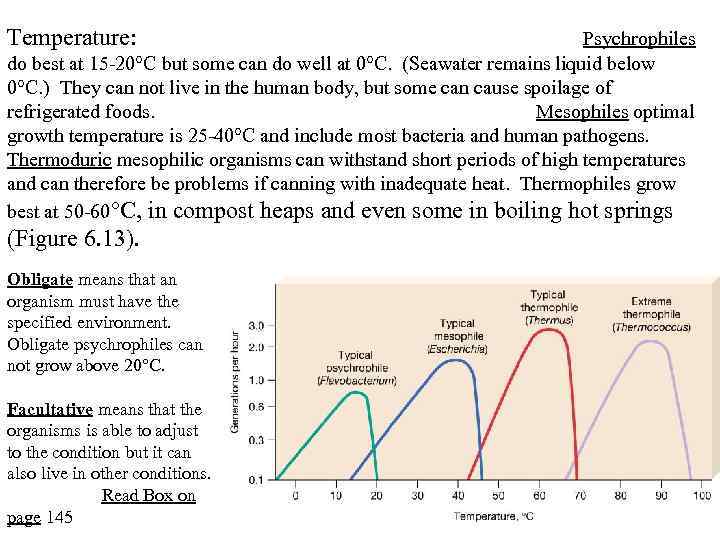
Temperature: Psychrophiles do best at 15 -20°C but some can do well at 0°C. (Seawater remains liquid below 0°C. ) They can not live in the human body, but some can cause spoilage of refrigerated foods. Mesophiles optimal growth temperature is 25 -40°C and include most bacteria and human pathogens. Thermoduric mesophilic organisms can withstand short periods of high temperatures and can therefore be problems if canning with inadequate heat. Thermophiles grow best at 50 -60°C, in compost heaps and even some in boiling hot springs (Figure 6. 13). Obligate means that an organism must have the specified environment. Obligate psychrophiles can not grow above 20°C. Facultative means that the organisms is able to adjust to the condition but it can also live in other conditions. Read Box on page 145
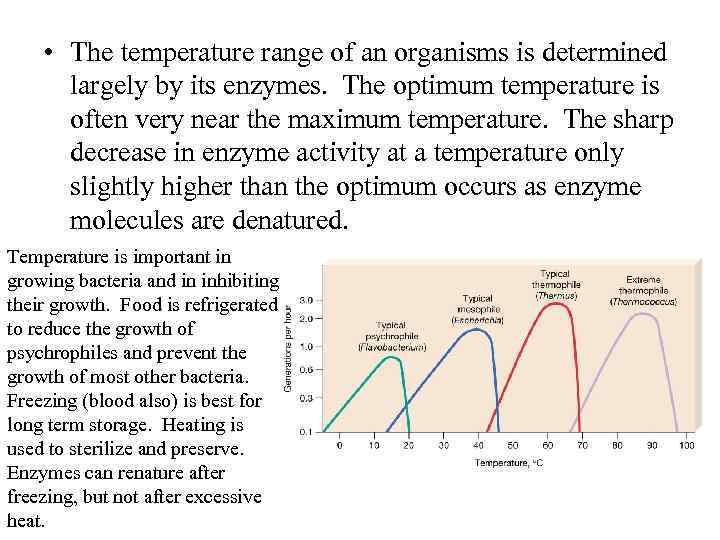
• The temperature range of an organisms is determined largely by its enzymes. The optimum temperature is often very near the maximum temperature. The sharp decrease in enzyme activity at a temperature only slightly higher than the optimum occurs as enzyme molecules are denatured. Temperature is important in growing bacteria and in inhibiting their growth. Food is refrigerated to reduce the growth of psychrophiles and prevent the growth of most other bacteria. Freezing (blood also) is best for long term storage. Heating is used to sterilize and preserve. Enzymes can renature after freezing, but not after excessive heat.
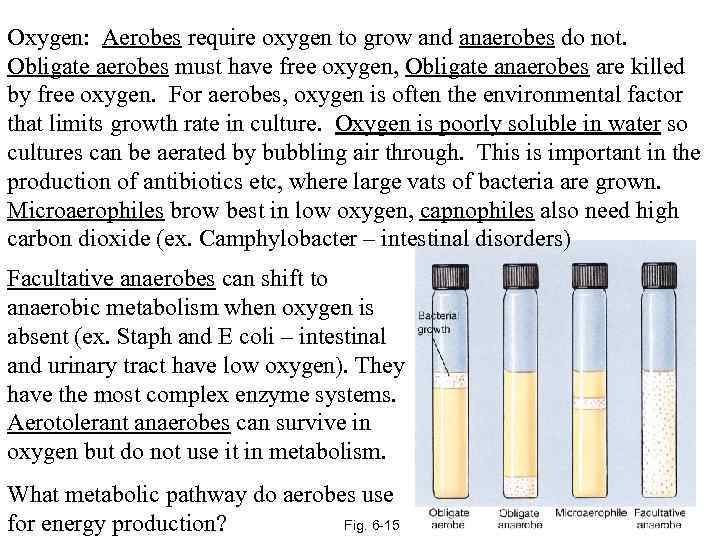
Oxygen: Aerobes require oxygen to grow and anaerobes do not. Obligate aerobes must have free oxygen, Obligate anaerobes are killed by free oxygen. For aerobes, oxygen is often the environmental factor that limits growth rate in culture. Oxygen is poorly soluble in water so cultures can be aerated by bubbling air through. This is important in the production of antibiotics etc, where large vats of bacteria are grown. Microaerophiles brow best in low oxygen, capnophiles also need high carbon dioxide (ex. Camphylobacter – intestinal disorders) Facultative anaerobes can shift to anaerobic metabolism when oxygen is absent (ex. Staph and E coli – intestinal and urinary tract have low oxygen). They have the most complex enzyme systems. Aerotolerant anaerobes can survive in oxygen but do not use it in metabolism. What metabolic pathway do aerobes use Fig. 6 -15 for energy production?
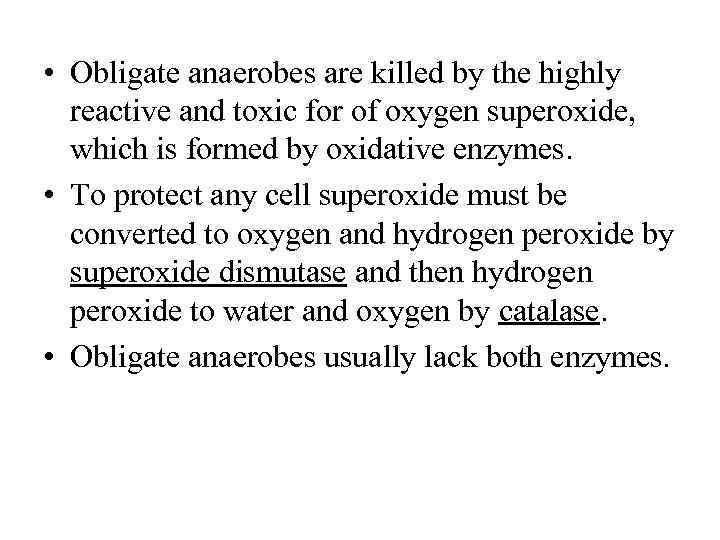
• Obligate anaerobes are killed by the highly reactive and toxic for of oxygen superoxide, which is formed by oxidative enzymes. • To protect any cell superoxide must be converted to oxygen and hydrogen peroxide by superoxide dismutase and then hydrogen peroxide to water and oxygen by catalase. • Obligate anaerobes usually lack both enzymes.
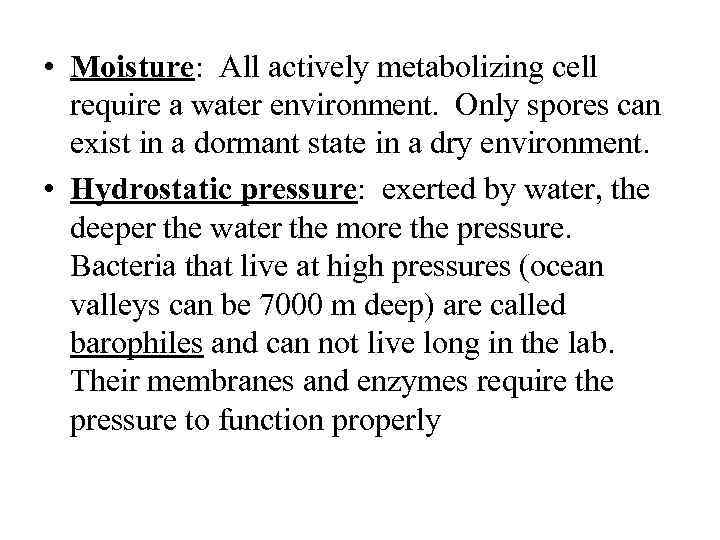
• Moisture: All actively metabolizing cell require a water environment. Only spores can exist in a dormant state in a dry environment. • Hydrostatic pressure: exerted by water, the deeper the water the more the pressure. Bacteria that live at high pressures (ocean valleys can be 7000 m deep) are called barophiles and can not live long in the lab. Their membranes and enzymes require the pressure to function properly
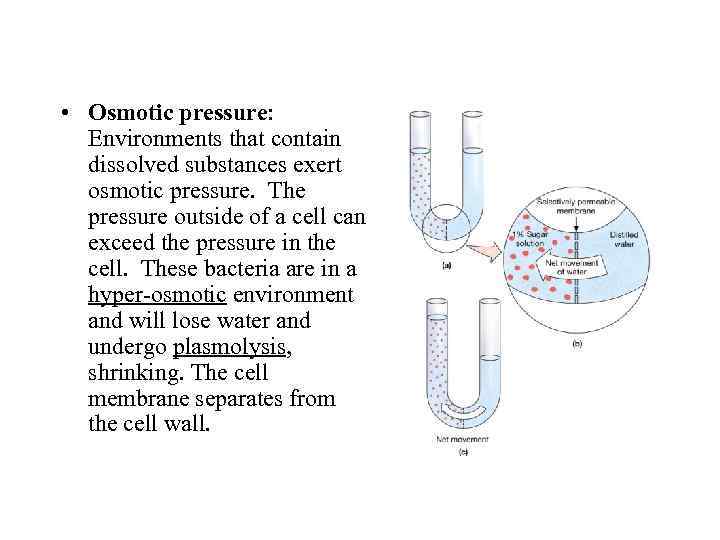
• Osmotic pressure: Environments that contain dissolved substances exert osmotic pressure. The pressure outside of a cell can exceed the pressure in the cell. These bacteria are in a hyper-osmotic environment and will lose water and undergo plasmolysis, shrinking. The cell membrane separates from the cell wall.
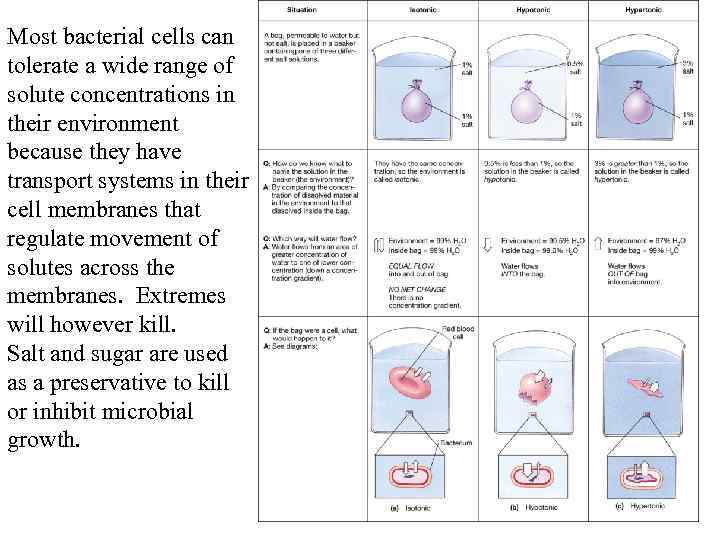
Most bacterial cells can tolerate a wide range of solute concentrations in their environment because they have transport systems in their cell membranes that regulate movement of solutes across the membranes. Extremes will however kill. Salt and sugar are used as a preservative to kill or inhibit microbial growth.
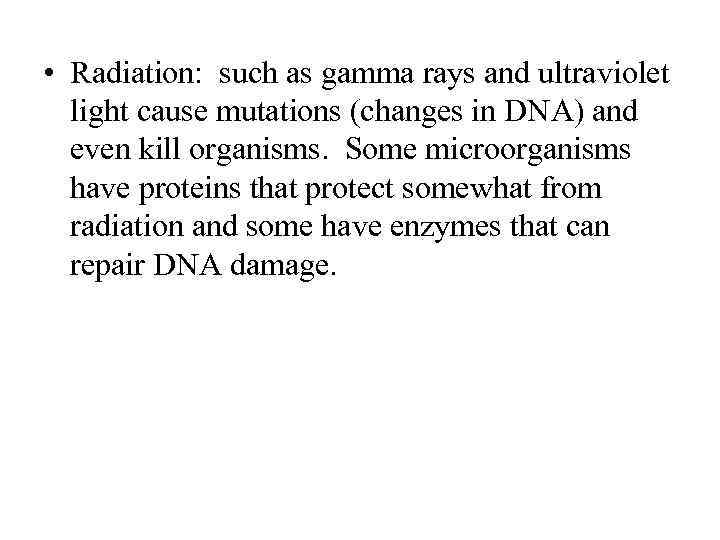
• Radiation: such as gamma rays and ultraviolet light cause mutations (changes in DNA) and even kill organisms. Some microorganisms have proteins that protect somewhat from radiation and some have enzymes that can repair DNA damage.
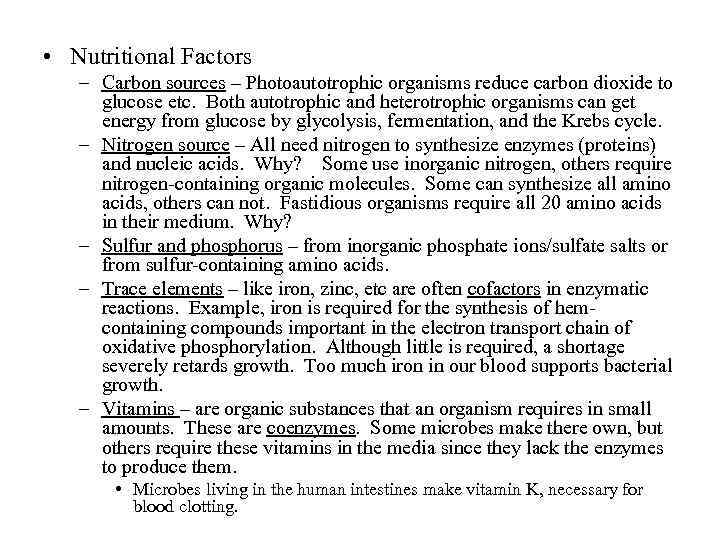
• Nutritional Factors – Carbon sources – Photoautotrophic organisms reduce carbon dioxide to glucose etc. Both autotrophic and heterotrophic organisms can get energy from glucose by glycolysis, fermentation, and the Krebs cycle. – Nitrogen source – All need nitrogen to synthesize enzymes (proteins) and nucleic acids. Why? Some use inorganic nitrogen, others require nitrogen-containing organic molecules. Some can synthesize all amino acids, others can not. Fastidious organisms require all 20 amino acids in their medium. Why? – Sulfur and phosphorus – from inorganic phosphate ions/sulfate salts or from sulfur-containing amino acids. – Trace elements – like iron, zinc, etc are often cofactors in enzymatic reactions. Example, iron is required for the synthesis of hemcontaining compounds important in the electron transport chain of oxidative phosphorylation. Although little is required, a shortage severely retards growth. Too much iron in our blood supports bacterial growth. – Vitamins – are organic substances that an organism requires in small amounts. These are coenzymes. Some microbes make there own, but others require these vitamins in the media since they lack the enzymes to produce them. • Microbes living in the human intestines make vitamin K, necessary for blood clotting.
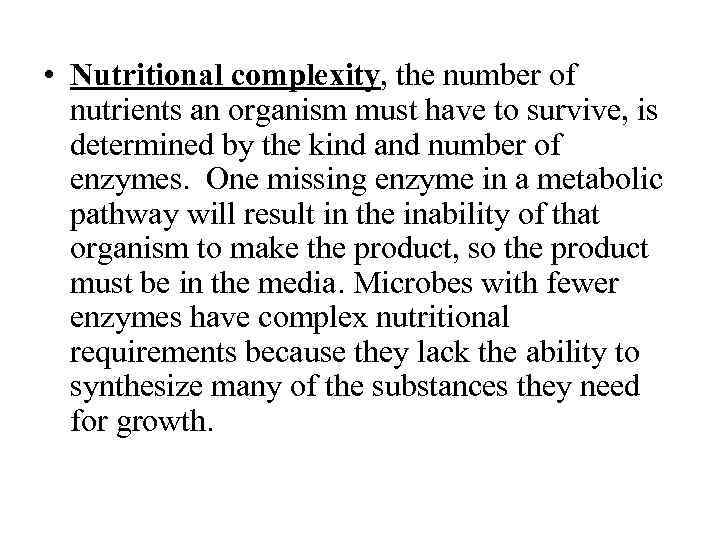
• Nutritional complexity, the number of nutrients an organism must have to survive, is determined by the kind and number of enzymes. One missing enzyme in a metabolic pathway will result in the inability of that organism to make the product, so the product must be in the media. Microbes with fewer enzymes have complex nutritional requirements because they lack the ability to synthesize many of the substances they need for growth.
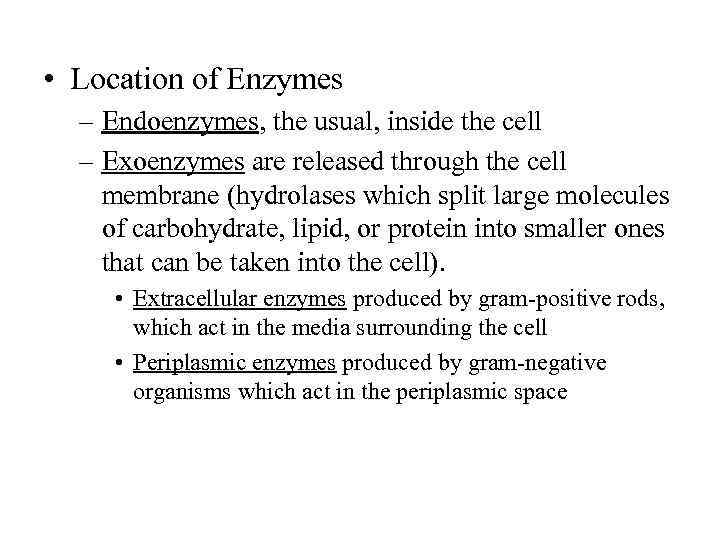
• Location of Enzymes – Endoenzymes, the usual, inside the cell – Exoenzymes are released through the cell membrane (hydrolases which split large molecules of carbohydrate, lipid, or protein into smaller ones that can be taken into the cell). • Extracellular enzymes produced by gram-positive rods, which act in the media surrounding the cell • Periplasmic enzymes produced by gram-negative organisms which act in the periplasmic space
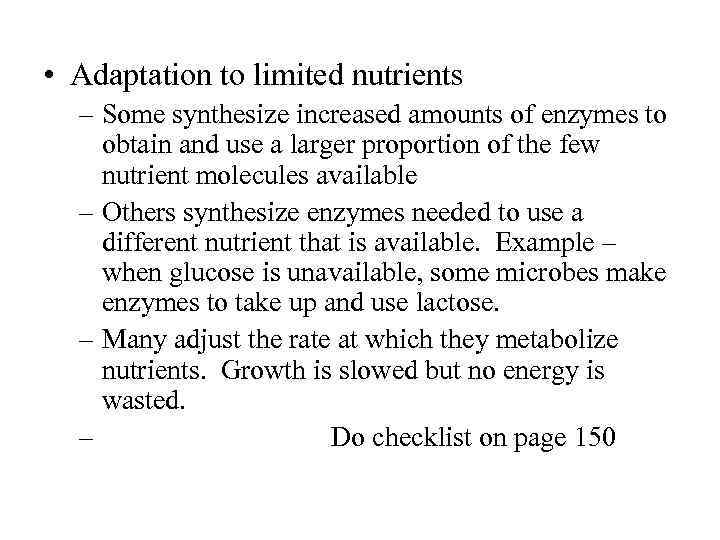
• Adaptation to limited nutrients – Some synthesize increased amounts of enzymes to obtain and use a larger proportion of the few nutrient molecules available – Others synthesize enzymes needed to use a different nutrient that is available. Example – when glucose is unavailable, some microbes make enzymes to take up and use lactose. – Many adjust the rate at which they metabolize nutrients. Growth is slowed but no energy is wasted. – Do checklist on page 150
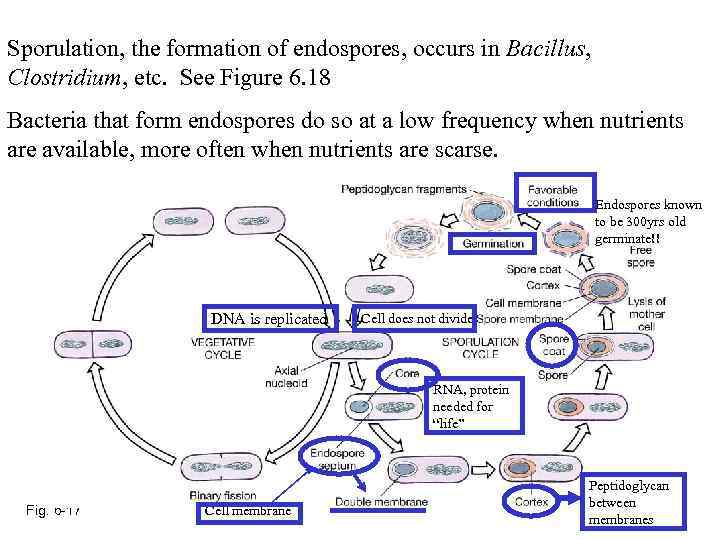
Sporulation, the formation of endospores, occurs in Bacillus, Clostridium, etc. See Figure 6. 18 Bacteria that form endospores do so at a low frequency when nutrients are available, more often when nutrients are scarse. Endospores known to be 300 yrs old germinate!! DNA is replicated Cell does not divide RNA, protein needed for “life” Fig. 6 -17 Cell membrane Peptidoglycan between membranes
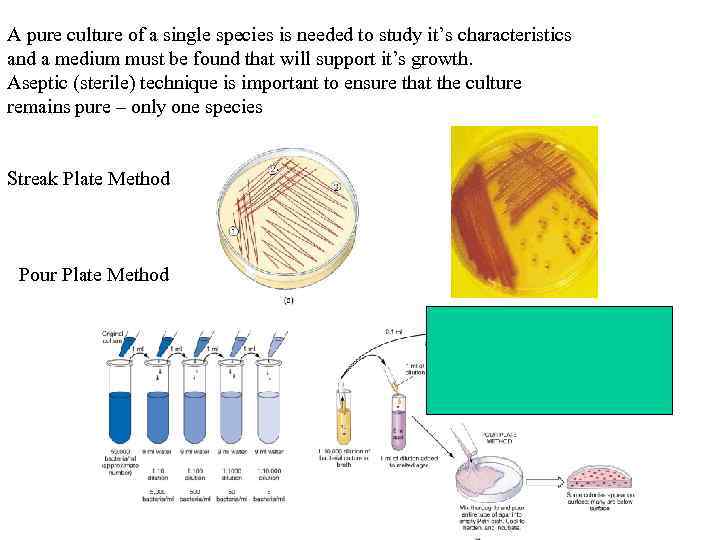
A pure culture of a single species is needed to study it’s characteristics and a medium must be found that will support it’s growth. Aseptic (sterile) technique is important to ensure that the culture remains pure – only one species Streak Plate Method Pour Plate Method
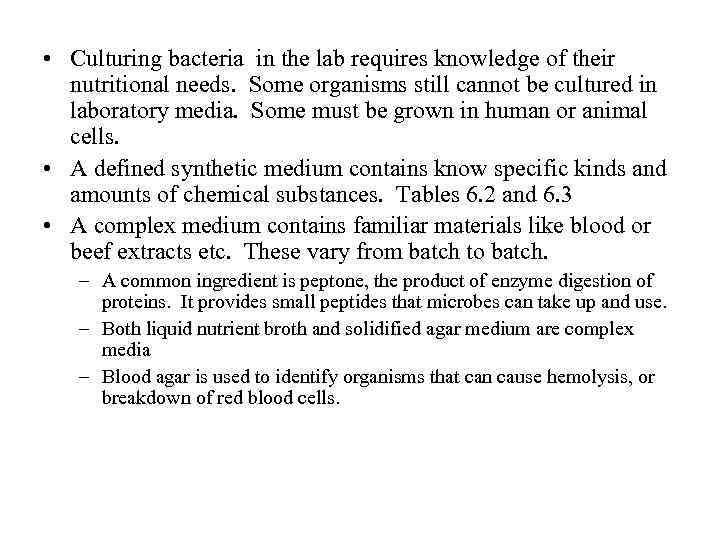
• Culturing bacteria in the lab requires knowledge of their nutritional needs. Some organisms still cannot be cultured in laboratory media. Some must be grown in human or animal cells. • A defined synthetic medium contains know specific kinds and amounts of chemical substances. Tables 6. 2 and 6. 3 • A complex medium contains familiar materials like blood or beef extracts etc. These vary from batch to batch. – A common ingredient is peptone, the product of enzyme digestion of proteins. It provides small peptides that microbes can take up and use. – Both liquid nutrient broth and solidified agar medium are complex media – Blood agar is used to identify organisms that can cause hemolysis, or breakdown of red blood cells.
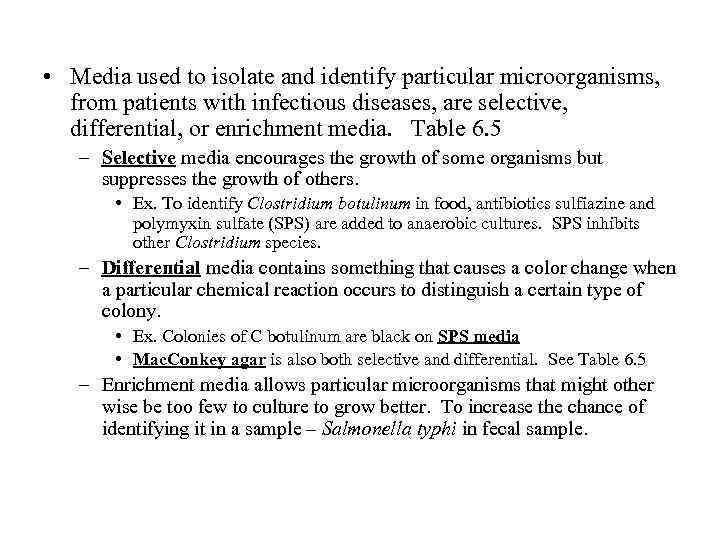
• Media used to isolate and identify particular microorganisms, from patients with infectious diseases, are selective, differential, or enrichment media. Table 6. 5 – Selective media encourages the growth of some organisms but suppresses the growth of others. • Ex. To identify Clostridium botulinum in food, antibiotics sulfiazine and polymyxin sulfate (SPS) are added to anaerobic cultures. SPS inhibits other Clostridium species. – Differential media contains something that causes a color change when a particular chemical reaction occurs to distinguish a certain type of colony. • Ex. Colonies of C botulinum are black on SPS media • Mac. Conkey agar is also both selective and differential. See Table 6. 5 – Enrichment media allows particular microorganisms that might other wise be too few to culture to grow better. To increase the chance of identifying it in a sample – Salmonella typhi in fecal sample.
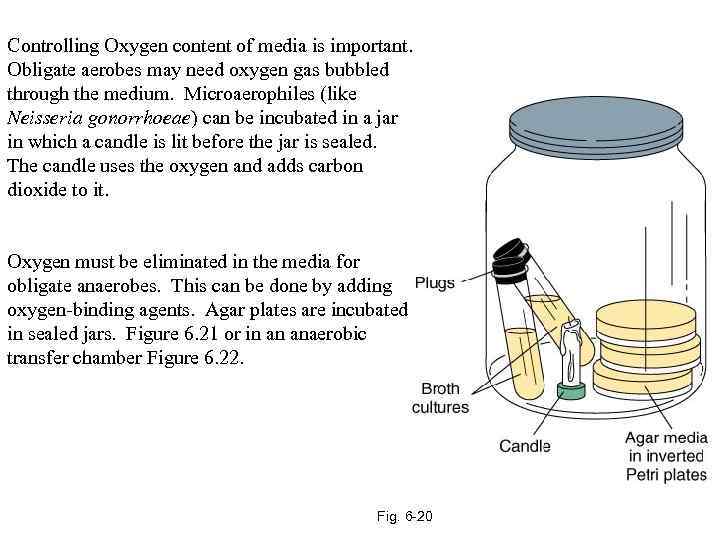
Controlling Oxygen content of media is important. Obligate aerobes may need oxygen gas bubbled through the medium. Microaerophiles (like Neisseria gonorrhoeae) can be incubated in a jar in which a candle is lit before the jar is sealed. The candle uses the oxygen and adds carbon dioxide to it. Oxygen must be eliminated in the media for obligate anaerobes. This can be done by adding oxygen-binding agents. Agar plates are incubated in sealed jars. Figure 6. 21 or in an anaerobic transfer chamber Figure 6. 22. Fig. 6 -20
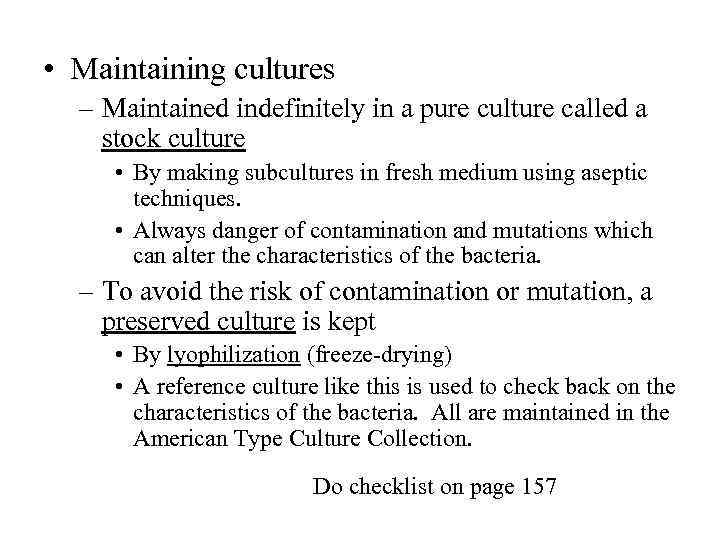
• Maintaining cultures – Maintained indefinitely in a pure culture called a stock culture • By making subcultures in fresh medium using aseptic techniques. • Always danger of contamination and mutations which can alter the characteristics of the bacteria. – To avoid the risk of contamination or mutation, a preserved culture is kept • By lyophilization (freeze-drying) • A reference culture like this is used to check back on the characteristics of the bacteria. All are maintained in the American Type Culture Collection. Do checklist on page 157
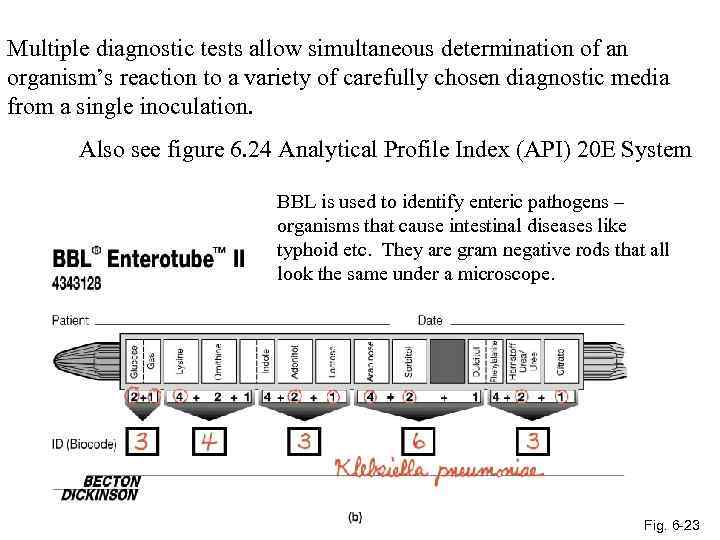
Multiple diagnostic tests allow simultaneous determination of an organism’s reaction to a variety of carefully chosen diagnostic media from a single inoculation. Also see figure 6. 24 Analytical Profile Index (API) 20 E System BBL is used to identify enteric pathogens – organisms that cause intestinal diseases like typhoid etc. They are gram negative rods that all look the same under a microscope. Fig. 6 -23
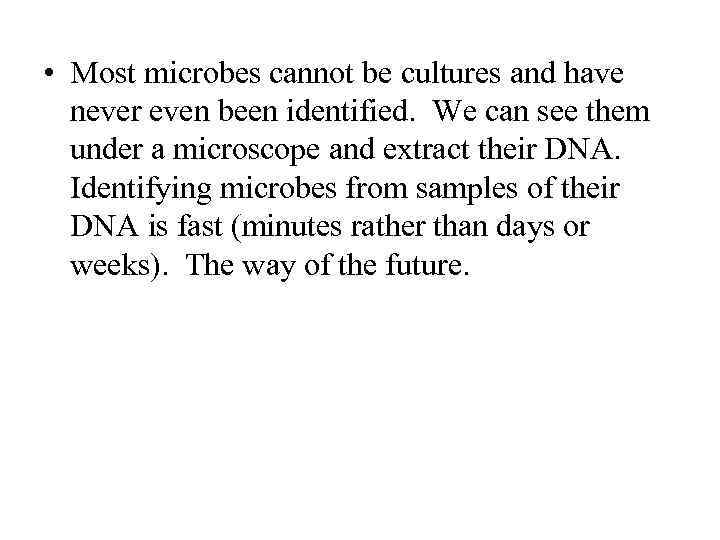
• Most microbes cannot be cultures and have never even been identified. We can see them under a microscope and extract their DNA. Identifying microbes from samples of their DNA is fast (minutes rather than days or weeks). The way of the future.
Extra reading.ppt